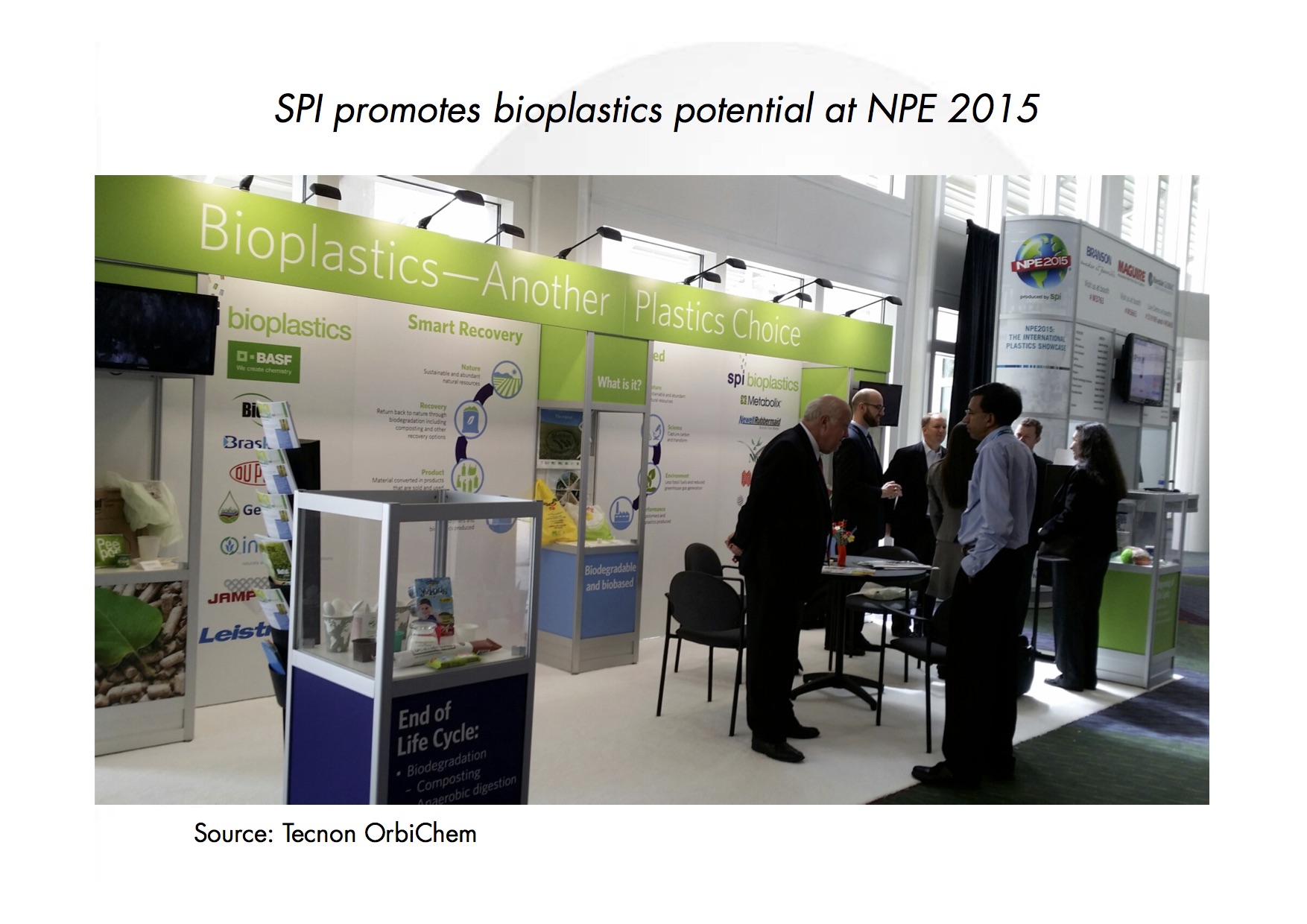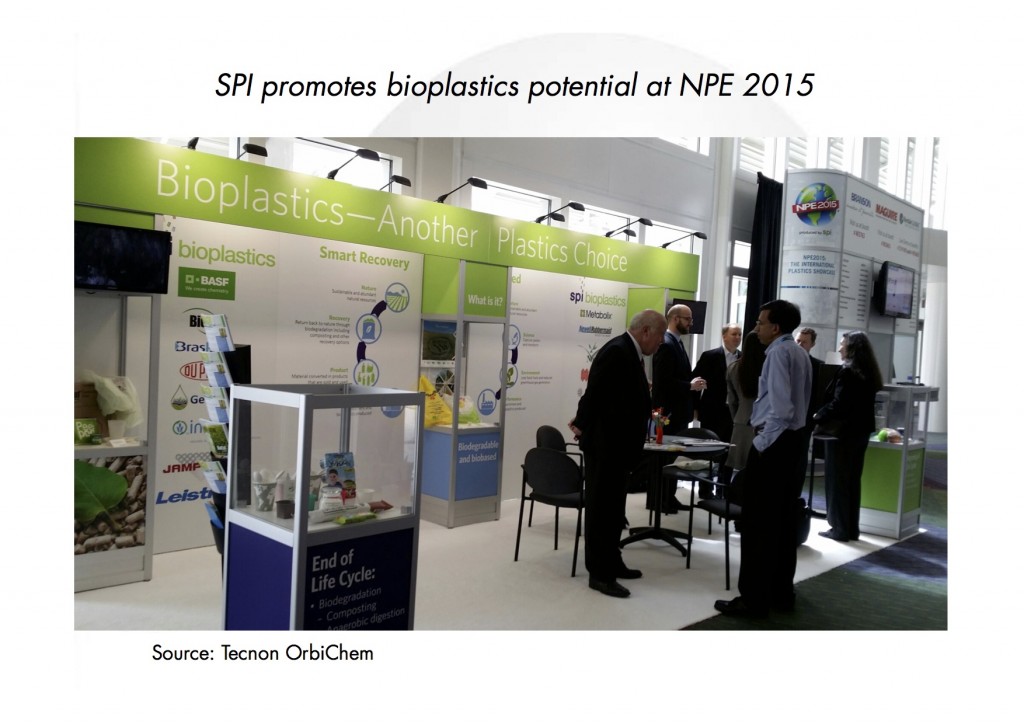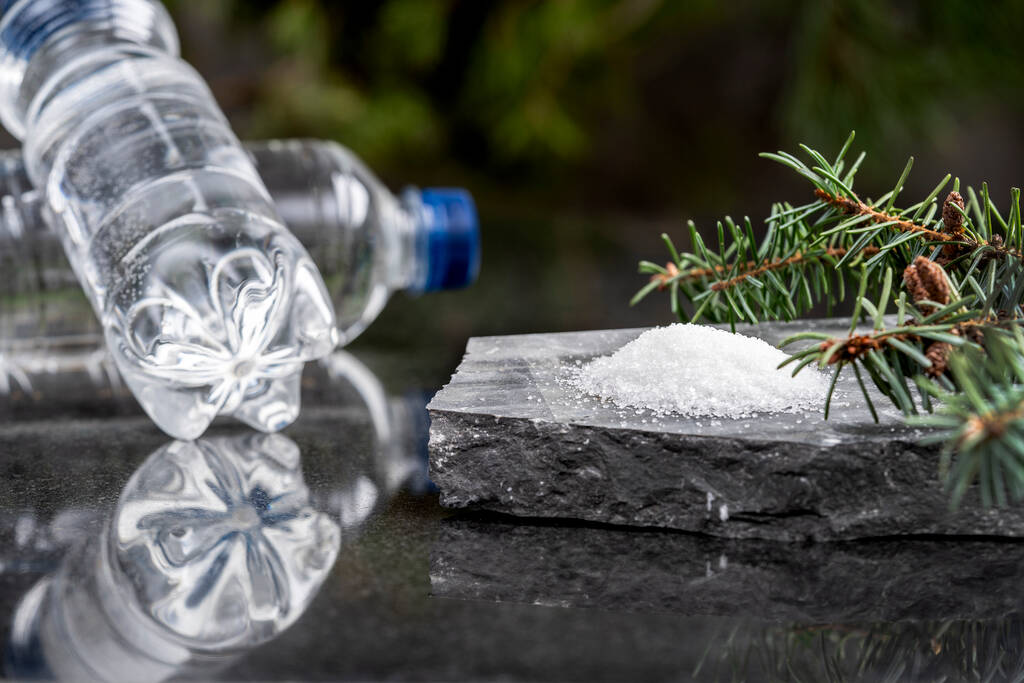I have begun to write special reports on Tecnon OrbiChem’s monthly Bio-Materials newsletter this year, and this is a sample that was written for the April issue. I’m thinking of doing a bio-based lubricants special for June as this space is seeing so many new bio-based alternatives to synthetics. Unfortunately, I cannot promise that I will be able to share that report in the blog.
SPECIAL REPORT
Bio-derived plastics and additives becoming mainstream
The recent NPE Plastics tradeshow held in Orlando, Florida, USA, was a platform for more acceptance for bio-based plastics and additives as several companies launched or highlighted bio-derived materials at the show, while the Bioplastics Division (BPD) of the Plastics Industry Trade Association (SPI), which produced the NPE tradeshow, spotlighted the increasing role of bioplastics at its own booth at the show. NPE2015 attracted over 2,029 exhibitors, with 65,810 registered attendees,, which was 19% higher than seen three years ago. Nearly 44% of exhibiting companies and 26% of registrants came from outside the US. SPI BPD noted that the bioplastics sector is expected to play an important role in the future of the plastics industry as a whole.
Bioplastics producers NatureWorks, Metabolix, MHG, Cathay Industrial Biotech, Shandong Fuwin New Material Co., Ltd., Biobent Polymers, Novamont, and Green Dot, among others have reported successful marketing campaigns and/or product launches at the NPE tradeshow promoting bioplastic or bio-derived plastic additives containing PLA, PHA, starch-based materials or cellulose materials.
3D printing was one of the major buzzwords at the NPE tradeshow and major PLA producer, NatureWorks, has been heavily promoting its new Ingeo™ PLA filament in 3D Printing, which reportedly offers better performance compared to ABS. Teknor Apex also highlighted its new Terraloy® high-heat, high-impact PLA plastic compounds for 3D printing. The company said the product range provides enhanced properties and tight tolerance control in 3D printing, while permitting oven drying of filament to prevent defects caused by residual moisture.
Metabolix is eyeing PHA as a replacement for PE and PP in microbead formulation in personal care products, and has recently partnered with Honeywell to supply the company with PHA pellets for conversion into microbeads sold under Honeywell’s Asensa product line. There are several pending legislations in the US focused on replacing synthetic, non-biodegradable microbeads as these are reportedly being flushed into marine environments, and can then be ingested by wildlife. Last month, New Jersey signed a bill that prohibits the production, manufacture and sale of personal care and cosmetic products containing synthetic plastic microbeads by January 2018. New Jersey followed Illinois in becoming the second state to pass such a measure. A bill pending in Congress could set a federal ban on the sale or distribution of such products starting in 2018. Metabolix touts PHA beads as sustainable and degradable in water systems.
It was particularly noteworthy to see traditional petrochemical-based polymer producers and suppliers such as Braskem, DSM, BASF, Arkema, Lubrizol, PolyOne, Teknor Apex, Radici, DuPont, Clariant, and SK Chemicals, DAK Americas, among others, touting the benefits of bio-derived polymers and additives at the show.
Braskem continues to attract customers for its sugarcane ethanol-based PE plastics, despite lower cost pressure from petrochemical-based PE plastics; mostly because of consumer demand for more environment-friendly packaging, as well as growing sustainability-based marketing efforts from consumer branded companies.
BASF says it is seeing a market niche for its bioplastic ecovio®, and has recently launched its ecovio® F Mulch for the US market as an alternative to conventional PE-based agricultural mulch film. US farmers now do not have to retrieve the film from the field to dispose of or recycle after the harvest, and can simply plough the biodegraded ecovio® mulch film along with what remains from the plants, saving them time and reducing costs, according to BASF. The company’s ecovio® is a combination of biodegradable polymers such as PLA with aliphatic-aromatic copolyester PBAT (polybutylene adipate co-terephthalate), a biodegradable and compostable polymer produced by BASF under the brand ecoflex®. PBAT is composed of BDO, adipic acid and terephthalic acid or dimethyl terephthalate in the polymer chain, depending on the production process.
There were several companies looking to replace phthalates plasticisers with bio-based solutions. PolyOne touted at the NPE tradeshow its Geon™ BIO flexible vinyl that incorporates its reflex™ 300 soybean oil-based plasticiser. The bio-based flexible PVC is mainly focused on consumer goods such as footwear and furniture applications. PolyOne is reportedly looking at other opportunities such as in medical devices, toys, and in building and construction. By using Geon™ Bio, customers can reportedly lower their systems costs, so the per-pound price is comparable with other materials. PolyOne noted that demand for the bioplasticisers is strong in North America, where companies face the possibility of product moving into California and being subjected to the state’s labelling laws. The trend toward phthalate-free products in the US is influenced by legislation like California’s Proposition 65.
Vertellus and Jungbunzlauer have also been promoting citric acid esters-based plasticisers. Jungbunzlauer’s Citrofol® esters plasticisers are reportedly compatible with a broad range of polymers such as PVC, PU, acrylics and even biopolymers such as cellulosics, PLA and PHA. Vertellus’ Citroflex® plasticisers for PVC and other polymers are targeting food-contact applications such as rigid food containers and packaging films, as well as children’s toys and medical applications. Vertellus said its bio-plasticisers deliver superior tensile strength and ultimate elongation performance compared to DEHP and DEHA. Vertellus also highlighted its castor oil-based Flexricin® and Paricin® bio-based plasticisers at the NPE tradeshow.
Start-up company, Genarex LLC, based in Georgia, USA, has launched its first bioadditives products, Bylox™ and Bylox™ HT, that are made from heterogeneous mixture of plant-based proteins, carbohydrates and lignin. The bio-based additives can be blended with PP, PE and PVC at loadings up to 30% without sacrificing material performance. They can also be added to biodegradable polymers such as PBAT, PLA and PHA at similar loading levels. The company expects to break ground on a new commercial-scale manufacturing facility in the near future.
In bio-polyurethanes, Lubrizol has been promoting its Bio-TPU™ line that has bio-based carbon content ranging from 30% to 80%. The product line includes Pearlthane™ ECO, a bio-based TPU for injection moulding and extrusion, and Pearlbond™ ECO, that can be added to reactive hotmelt formulations and hotmelt adhesives in heat-sealable fabrics and in toe puffs and counters.
Several companies have also highlighted bio-polyamides, including Radici Group, Arkema, DSM, Evonik, and Cathay Industrial Biotech.
At the NPE tradeshow, the SPI Bioplastic Division also awarded Eastman Kodak the winner of the 2015 Innovation in Bioplastics award for its creation of bio-toner, designed for the electro-photographic printing industry that contains greater than 90% bio-based and biodegradable materials. Eastman Kodak used the Ingeo™ PLA resin as well as natural waxes for the bio-toner. Having a high percentage of PLA makes the de-inking process for the material much simpler, according to Eastman Kodak, and the resulting waste material that is left over contains mostly lactic acid.
The global toner resin market is reportedly worth $1 billion, each year in the printing industry for electrophotographic toners. One third of that goes into chemical toner production, of which colour toner production accounts for 98%. Bioresins currently account for only 1% of colour toners and 10% of monochrome toners, but developing economically viable bio-based toners that can be used at 100% incorporation, as Eastman Kodak’s bio-based toner aims to do, can capture greater market share. Eastman Kodak expects its bio-based toner to be widely available by May or June this year.





